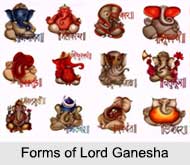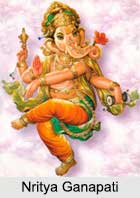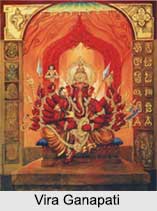 Forms of Lord Ganesha are mentioned in the ancient Puranic texts, like the Mahapuranas and the Upapuranas. There are 32 Forms of Lord Ganesha. Each of the appearance of the deity depicts different traits of Lord Ganesha. Lord Ganesha is believed to be the Patron of Letters, Arts and Sciences; the Lord of Beginnings and Success; the deity of wisdom and intellect; and the Remover of Obstacles.
Forms of Lord Ganesha are mentioned in the ancient Puranic texts, like the Mahapuranas and the Upapuranas. There are 32 Forms of Lord Ganesha. Each of the appearance of the deity depicts different traits of Lord Ganesha. Lord Ganesha is believed to be the Patron of Letters, Arts and Sciences; the Lord of Beginnings and Success; the deity of wisdom and intellect; and the Remover of Obstacles.
Significance of 32 Forms of Lord Ganesha
As Lord Ganesha is considered to be one of the Pancha Devas in Hinduism, the lord is worshipped with foremost importance. It is widely believed that a person who chants the 32 forms of Lord Ganesha before commencing his studies; while entering a new house or a town; before the beginning of a journey; during the period of marriage; during the commencement of a combat or during periods of disaster, the individual will achieve success in his task and will be able to overcome all obstacles in his path.
32 Forms of Lord Ganesha
Each of the 32 names or Forms of Lord Ganesha are discussed below –
Bala Ganapati: Bala Ganapati is the "Childlike" God with golden hue. He holds a banana, mango, sugarcane and jackfruit in his arms, all representing the earth"s abundance and fertility. His trunk garners His favourite sweet, the modaka.
Taruna Ganapati: Taruna Ganapati, the "Youthful", holds a noose and goad, modaka, wood apple, rose apple, His broken tusk, a spring of paddy and a sugarcane stalk in his 8 arms. His brilliant red colour reflects the blossoming of youth.
Bhakti Ganapati: Shining like the full moon during harvest season and garlanded with flowers - Bhakti Ganapati is dear to devotees, is indeed pleasant to look upon. He holds a banana, a mango, coconut and a bowl of sweet Payasam.
Vira Ganapati: The "Valiant Warrior", Vira Ganapati assumes a commanding pose. His 16 arms bristle with weapons, symbols of mind powers: a goad, discus, bow, arrow, sword, shield, spear, mace, a battleaxe, a trident and more.
Shakti Ganapati: Four-armed and seated with one of his shaktis on his knee - Shakti Ganapati, the "Powerful", with orange-red hue, guards the householder. He holds a garland, noose and goad, and bestows blessings with the Abhaya Mudra.
Dvija Ganapati: Four-headed Dvija Ganapati, the "Twice-born", is moon-like in colour. Holding a noose, a goad, a leaf scripture, a staff, water vessel and japa beads, He reminds one and all of the urgency for disciplined striving.
Siddhi Ganapati: Golden- yellow Siddhi Ganapati, the "Accomplished" is the epitome of achievement and self-mastery. He sits comfortably holding a bouquet of flowers, an axe, mango, sugarcane and in his trunk he holds sesame sweet.
Ucchhishta Ganapati: Ucchhishta Ganapati is "Lord of Blessed Offerings" and guardian of culture. He posses blue complexion and 6 arms, He sits with his Shakti, holding a Veena, pomegranate, blue lotus flower, japa mala and a spring of fresh paddy.

Vighna Ganapati: Vighna Ganapati, "Lord of Obstacles" is of brilliant gold hue and bedecked in jewels. His 8 arms hold a noose and goad, tusk and modaka, conch and discus, a bouquet of flowers, sugarcane, flower arrow and an axe.
Kshipra Ganapati: Handsome and red-hued Kshipra Ganapati is "Quick-giver" of boons, he displays broken tusk, a noose, goad and a spring of the kalpavriksha tree. In his uplifted trunk he holds a tiny pot of precious jewels.
Heramba Ganapati: Five-faced, white in colour, Heramba Ganapati is "Protector of the Weak" and rides a big lion. He extends the gestures of protection and blessing while holding a noose, japa beads, axe, hammer, tusk, garland, fruit and modaka.
Lakshmi Ganapati - He is depicted as the pure white giver of success, sits flanked by Wisdom and Achievement. Gesturing Varada Mudra, He holds a green parrot, a pomegranate, sword, goad, noose, sprig of kalpavriksha and a water vessel.
Kshipra Prasada Ganapati: As the name suggest Ganapati the quick rewarder. He sits on a Kusha grass throne and his big belly symbolizes the universe. His hands hold broken tusk, the twig of Kalpavriksha, noose, an elephant goad, pomegranate and a white lotus.
Maha Ganapati: Accompanied by one of His shaktis, the "Great" Ganapati is red-complexioned and three-eyed. He holds His tusk, a pomegranate, blue lily, sugarcane bow, discus, noose, lotus, paddy spring, mace and a pot of gems.
Vijaya Ganapati: Four-armed with red hue and riding on resourceful mushika, Vijaya Ganapati is the "Victorious bestower of successes. His insignia are the broken tusk, elephant goad, a noose and a luscious golden mango.
 Nritya Ganapati: The happy dancer, "Nritya Ganapati" is 4 armed and golden, with rings on His fingers, holding a tusk, goad, noose and modaka sweet. He prances under the kalpavriksha tree, epitomizing exuberant activity and joy.
Nritya Ganapati: The happy dancer, "Nritya Ganapati" is 4 armed and golden, with rings on His fingers, holding a tusk, goad, noose and modaka sweet. He prances under the kalpavriksha tree, epitomizing exuberant activity and joy.
Urdhva Ganapati: Seated with one of his shaktis on his left knee, Urdhva Ganapati is the "Elevated Lord" of golden hue. In his 6 hands he holds a spring of paddy, a lotus, the sugarcane bow, an arrow, His ivory tusk and a blue water lily.
Ekakshara Ganapati: Ekakshara Ganapati is three-eyed, with red complexion and attire. Crescent moon on His crown, He sits in lotus pose upon Mushika, offers the boon-giving gesture and holds a pomegranate, noose and goad.
Varada Ganapati: Varada Ganapati is "the Boon-Giver" with prominent third eye of wisdom, holds a dish of honey, the noose and goad and encloses a pot of jewels in His trunk. His Shakti is at His side, and the crescent moon adorns His crown.
Tryakshara Ganapati: Tryakshara Ganapati is "the Lord of Three Letters" i.e., A-U-M. He carries the broken tusk, goad, noose and mango and is often seen grasping a sweet modaka in His trunk.
Haridra Ganapati: Haridra Ganapati, the golden one dressed in bright yellow vestments, sits calmly on a posh, regal throne. Along with His tusk and a modaka, He wields a noose to hold devotees close and a sharp goad to spur them onward.
Ekadanta Ganapati: Ekadanta Ganapati is distinguished by his blue colour and sizeable belly. The attributes of this murti are an axe for cutting the bonds of ignorance, prayer beads for japa, a Laddoo sweet and the broken right tusk.
Srishti Ganapati: Riding on a mouse, Srishti Ganapati is the lord of happy "Manifestation". This active God, of red complexion, holds His noose, a goad, a perfect mango, and His tusk, representing selfless sacrifice.
Uddanda Ganapati: Uddanda Ganapati is the bold "Enforcer of Dharma". His 10 hands hold a pot of gems, a blue lily, sugarcane, a mace, lotus flower, spring of paddy, a pomegranate, noose, garland and His broken tusk.
Rinamochana Ganapati: Rinamochana Ganapati is humanity"s liberator from guilt and bondage. He bears a noose and a goad, His milk-white tusk and a favourite fruit, the rose apple.
Dhundhi Ganapati: Dhundhi Ganapati holds a strand of Rudraksha beads, His broken tusk, an axe and a small pot of precious gems thought to represent the treasury of awakenings He saves for all ardent devotees.
Dvimukha Ganapati: Dvimukha Ganapati has two divergent faces that see in all directions. His blue-green form is dressed in red silk. He wears a bejewelled crown and holds a noose, goad, His tusk and a pot of gems.
Trimukha Ganapati: Trimukha Ganapati is a "three-faced" Lord of red hue, sits on a golden lotus, holding a noose, goad and vessel of nectar. He gestures protection with a right hand and blessings with a left.
Simha Ganapati: Simha Ganapati rides a lion and displays another lion in one hand, symbolizing strength and fearlessness. He also holds a kalpavriksha spring, the Veena, a lotus blossom, flower bouquet and a pot of jewels.
Yoga Ganapati: Yoga Ganapati is absorbed in mantra japa. His knees strapped in meditative pose, hands holding a yoga staff, sugarcane stalk, a noose and prayer beads. His colour is like the morning sun.
Durga Ganapati: Durga Ganapati waves the flag of victory over darkness. His murti is of deep gold hue, dressed in red, holding a bow and arrow, noose and goad, prayer beads, broken tusk and a rose apple.
Sankatahara Ganapati: Sankatahara Ganapati, "the Dispeller of Sorrow," is of sun-like hue, dressed in blue, and seated on a red lotus flower. He holds a bowl of pudding, a goad and a noose while gesturing the boon-granting Varada Mudra.




















